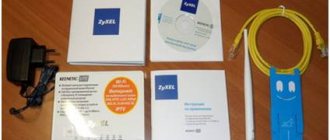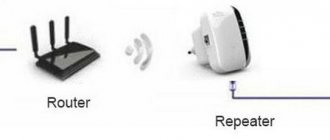Author of the article
Sergey Sakadynsky
He worked in the field of IT consulting, was engaged in the creation and administration of Internet resources. 10 years of experience in designing and maintaining computer networks.
Ask a Question
Three generations of home Wi-Fi routers have been released under the Zyxel Keenetic brand. In 2022, the Zyxel prefix disappeared and Keenetic became an independent brand. But thousands of older routers are still doing the job. Below we will talk about how to set up a Zyxel Keenetic Wi-Fi router with firmware 2.11 and previous versions.
Features of routers
Zyxel Keenetic routers have a simple and laconic design; visually all models are similar to each other. The difference is in the number of antennas, ports and buttons. For example, some devices have a button for switching operating modes. Top models may have two USB connectors, while budget models may have none.
Keenetic stands out among its competitors due to its software - a full-fledged operating system that turns the router into a universal Internet center. All models use the same software and are configured in exactly the same way. The latest version for Zyxel Keenetic is NDMS OS 2.11. We will talk about the setup using its example.
Banning sites or parental controls
The router OS allows you to use 3 built-in software filters: AdGuard, Yandex.DNS, SkyDNS (paid service) and Yandex.DNS. Each of these filters has its own advantages and configuration nuances. But before installing this or that component, you need to register the device on your home network:
NOTE! I did not describe SkyDNS, since it is free only for the first 15 days.
- Go to the “Device List”.
- Now go to the section “Unregistered devices” . Click on the required one.
- For convenience, enter the device name. For example: “Daughter’s PC” or “Wife’s PC” .
- Click “Register” .
Yandex.DNS
- Go to the “Internet Filter” and install “Yandex.DNS”.
- Next, for each registered device, you can set filters by class.
| Access class | Description |
| No filtering | No ISP DNS rules |
| Basic Internet | Without rules, reliable DNS from Yandex |
| Safe | Protection from suspicious sites that can spread viruses or deceive people. |
| Family | Blocking dangerous sites and pages for adults. |
AdGuard
The setup is the same as for Yandex, only AdGuard has two modes:
- No filtering – blocks advertising, phishing and tracking;
- Family – everything above + blocking adult sites, the search will filter words and block the output of links to unwanted sites.
Installation and preparation
If your Zyxel Keenetic has already been used before, reset its settings to factory settings before turning it on for the first time. Connect the power adapter and plug it into a power outlet. Connect the Internet cable to the blue WAN port on the rear panel. There is a power button there. Click it. At least two indicators should light up on the front panel - power and Internet connection.
To configure, you need to connect the Zyxel Keenetic router to the computer using the cable that comes in the kit. In the PC network card settings o.
Connect a cable from the card connector to any LAN port on the router. Now you can start setting up your Internet connection.
⇡#Technical characteristics
ZyXEL Keenetic Giga II, and at the same time the simple Keenetic II along with Keenetic Ultra, is based on the Mediatek (formerly Ralink) RT6856 MIPS processor operating at a frequency of 700 MHz. In addition, it has a pair of PCI-E and USB interfaces, supports hardware NAT acceleration, and also has a gigabit network interface connected to the Realtek RTL8367RB switch. The Ralink RT5392 radio module in this case provides support for Wi-Fi 802.11 b/g/n (up to 300 Mbit/s) with a MIMO 2×2:2 configuration. All this is spiced up with 256 MB of DDR2 RAM and 16 MB of system flash memory. Taken together, we get a good modern hardware platform. It works under the control of the NDMS system, which is internally somewhat different from most firmware used in routers.
| Router ZyXEL Keenetic Giga II | |
| Wi-Fi standards | IEEE 802.11 b/g/n (2.4 GHz) |
| Chipset/controller | Mediatek/Ralink RT6856 (700 MHz) + RT5392; Realtek RTL8367RB |
| Memory | RAM 256 MB/ROM 16 MB |
| Antennas | 2 x detachable omnidirectional 5 dBi; RP-SMA; 2x2:2 MIMO |
| Safety | 64/128-bit WEP/WPA/WPA2, 802.1x, 802.1Q, WPS |
| Wi-Fi speed | 802.11n: up to 300 Mbps, 802.11g: up to 54 Mbps, 802.11b: up to 11 Mbps |
| Interfaces | 5 x 10/100/1000 Mbps LAN/WAN, 2 x USB 2.0 |
| Indicators | Power, Network status, 1 x Wi-Fi, 5 x LAN/WAN, 1 x USB |
| Hardware buttons | Power, Wi-Fi + WPS off, factory reset, FN button |
| Dimensions (WxDxH) | 158x110x32 mm |
| Weight | 270 g |
| Nutrition | PSU AC 100-240 V, 50/60 Hz, 0.5 A; DC 12 V, 1.5 A |
| Guarantee | 1 year |
| Price | 3,300 rubles |
Connection
Your router can connect to the Internet in different ways.
Wired
Cable connection (Ethernet) is the most common. The provider runs a wire into the apartment. You connect it to the WAN interface and configure it according to the instructions. There are different types of connections, and we will look at them in detail below.
USB modem
Where there is no wired Internet, you can use the mobile network. If, of course, your router model has a USB port. To do this, you will need to purchase a USB modem and an operator SIM card. Insert the modem into the connector. You don’t need to configure anything else: the Internet connects automatically.
To check your connection, log into the web interface, open the “Internet” page (globe icon at the bottom) and go to the 3G/4G tab. Your mobile network connection will be displayed here. If you click on it, a window with additional information will open.
Be sure to read the list of supported modems on the Keenetic website in advance. If you purchase a device that is not there, it is not a fact that the Internet will work. In this case, you can try updating the firmware, but this does not always help.
WiFi
This method is rarely used. Perhaps your provider provides Internet access via Wi-Fi. Or you agreed with your neighbor to share the Internet through his wireless network.
This mode of operation is called “Bridge”. Do not confuse it with a repeater (repeater). In this case, the router transfers the Internet from the external network to its own.
To set up your connection, click on the Globe icon and select the Wi-Fi tab. Here, check the box next to “Enable Wi-Fi client”. Then click the "Browse networks" button and select the one you are going to connect to. And enter the network key. If the router you are connected to automatically distributes IP addresses, the corresponding data will be pulled up on its own. Otherwise, uncheck “Obtain an address via DHCP” and enter the IP yourself.
Internet center ZyXEL Keenetic
In the new line of ZyXEL Internet centers, the oldest is the “simply” Keenetic model. Its “seniority” refers exclusively to the Keenetic line in question, and not to ZyXEL products as a whole, and is only relevant until the line has expanded upward. The Keenetic model uses a faster processor, and the built-in Wi-Fi access point is built according to the 2T2R scheme with support for speeds up to 300 Mbit/s.
However, these characteristics are not the only ones of interest. Keenetic has a USB port that can be used to connect various devices - drives, printer and USB modem. Moreover, they can all be connected simultaneously through the hub. As a result, the user can get some of the functions of a network drive - access to disks via the SMB and FTP protocols and even offline downloading of torrents. Let's see how effectively this Internet center works in various scenarios.
Contents of delivery
As we have already said in previous articles, the packaging and packaging of ZyXEL products deserve an extremely positive assessment. All information, manuals, descriptions, programs and even the web interface are presented in Russian.
The equipment is standard for ZyXEL Internet centers - the device itself, a 12 V 1.5 A switching power supply, two antennas with a gain of 5 dBi, a network patch cord, a CD with programs and manuals, a warranty card, a full user manual . The only thing that attracts attention is the unexpectedly powerful power supply - it was required to ensure reliable operation of USB devices connected to the Internet center.
Appearance
The design of the device is similar to the previously reviewed Keenetic 4G - white glossy top, light gray matte bottom. Only now the dimensions have become a little larger - 16.2 × 11.2 × 3 centimeters. On the front rounded end there are status indicators for ports and connections. On the sides there are passive ventilation grilles and a USB port on the left side. There is only one, but if you need to connect several devices at once, you can use a USB hub.
On the rear panel you can find two connectors for Wi-Fi antennas, a hardware switch for the wireless module, a WPS button, a configuration reset button, four LAN ports and a WAN port, as well as a connector for connecting a power supply.
If necessary, the device can be mounted on the wall.
Hardware configuration
This time the filling is a little more powerful than other models in the line - Ralink RT3052 processor with a frequency of 384 MHz, 32 MB RAM, 8 MB flash chip. The processor integrates an Ethernet switch, an 802.11n radio module (2T2R, up to 300 Mbit/s) and a USB controller. On the board you can find a console connector. Perhaps this is a feature of the test sample, since we have not seen it on other devices in the line.
The device has a hardware switch for the wireless module. It works very quickly and efficiently - the state changes in just a couple of seconds. This is a fairly convenient way to increase the security of your home network.
The dimensions of the printed circuit board have also increased slightly - to 14x9.5 centimeters. The processor is covered with a small metal plate to improve cooling.
The device was tested with firmware version V1.00(BFW.2b)D0. In tests for the speed of working with a network drive, we additionally used a version with the NTFS driver from Tuxera.
Settings and features
Like other modern devices manufactured by ZyXEL, you can configure Keenetic to connect your home network to the Internet through the NetFriend program. This is the simplest and most convenient method if your provider is known to her and does not impose any specific requirements such as authorization through a script.
But since the device in question has significantly more capabilities than just providing Internet access, you will most likely have to turn to the web interface. In the new Keenetic line, it is presented exclusively in Russian and has retained the structure familiar to other models. In this section we will look at the basic network capabilities, and we will devote the next one to working with USB devices.
After entering a password to access the interface, the user is taken to the monitoring page. It displays the main parameters and current state of the device. Most of the information is provided with hyperlinks to other sections of the web interface for changing the corresponding options.
The item for setting up an Internet connection automatically changes its appearance depending on the selected operating mode of the device - Ethernet, 3G/4G, Wi-Fi. In the first case, the device can work with direct connection, PPPoE/PPTP/L2TP and supports MPPE encryption and 802.1x authorization.
The manufacturer pays special attention to the fact that all connection options and support for all compatible USB modems actually work on the same official firmware and you do not need to look for alternative options.
The user can change the IP and MAC addresses. There is a built-in DDNS client for three different services and the ability to program your own static routes.
In the “Home Network” group, the internal address of the Internet center, DHCP server options (including address reservation) are set, IPTV is configured (selection of physical ports or VLANs) and port translation is programmed. The proprietary TVport technology allows, in particular, to significantly reduce the load on the main processor of the device when broadcasting IPTV, working with traffic at the hardware level of the switch, and in many cases it works completely “transparently” for the user without special settings. Note that there is support for multicast transmission over Wi-Fi.
The volume of the list for providing access to local services is a hundred entries, each of which includes an IP address, starting and ending port numbers (internal and external in this firmware are the same, but the manufacturer is already working on firmware with PAT support), protocol (TCP , UDP or both). You can enable the transfer of all (except those specifically specified previously) incoming requests to a specific client in the local segment.
The built-in wireless access point operates using 802.11b/g/n protocols and supports connections at speeds up to 300 Mbps. It does not have any special settings: network name, choice of standard and channel, access control mode (open network, WEP, WPA/WPA2). A list of “black” or “white” MAC addresses is provided. On a separate page you can see a list of connected clients indicating the duration of the session. The device supports WPS, making it easy to securely connect new devices.
A separate group of pages with settings is dedicated to various traffic filters. In particular, there are “black” or “white” lists of MAC and IP addresses. There is also a service filter (blocking external resources by port numbers) and a URL filter (programming keywords in the blocking link).
Of the system options, the first thing worth noting is the choice of operating mode. Keenetic can provide Internet access via a dedicated Ethernet line, via 3G/4G networks (using appropriate modems) or via Wi-Fi networks. In the last two cases, all five wired ports are available for connecting clients. There are also access point and wireless bridge modes.
Standard capabilities are provided for working with configuration, firmware and administrator password. The port numbers for accessing the web interface and telnet can be changed, as well as providing access to them from the Internet.
The built-in clock of the device can be synchronized via the Internet. The built-in log can be sent to the syslog server. There is no email option. The log itself does not have any settings for displaying events and, apparently, represents grouped reports from the embedded Linux OS and a number of software modules. Unfortunately, its information content is not optimal for a home system - there are many system messages (for example, about the process of loading the OS), but at the same time there is no information about who is connecting via Wi-Fi and when and who is assigned which addresses, not to mention already about the operation of access blocking functions.
Working with USB devices
The Keenetic model has one USB 2.0 port on the left side. It can be used to connect storage devices, a printer, and cellular modems. Moreover, several devices can work simultaneously through a USB hub. But in this case, it is recommended to pay special attention to the power supply of the disks and the hub itself.
We talked about the option of working with a 3G/4G modem in the review of the Keenetic 4G model, so we won’t dwell on it in detail. This feature allows you to provide Internet access to your home or office network through most domestic cellular operators or broadband mobile Internet providers, such as Yota.
The second (or even the first) most popular option is connecting external drives to implement some of the functions of network drives. Keenetic supports multiple devices at once, understands partitions, and compatible file systems are FAT32/NTFS/EXT2/EXT3. The device cannot format disks. To safely disconnect external drives, you can use the web interface or reassign the WPS button. Each partition or disk receives a network name of the form DISK_A1, where “A” indicates the disk number, and “1” indicates the partition number.
The device provides access to data via the SMB/CIFS (normal Windows network environment) and FTP protocols. In the first case, you can change the name of the server and workgroup; in the second, you can change the port number (command only) and open access from the Internet. In addition, the FTP server supports passive mode, adding files, working in multiple threads, and Russian file and directory names when using a UTF8-compatible client. The maximum number of simultaneous connections is ten. It is apparently dictated by the hardware characteristics of the device.
To limit access to network resources, there is an option to program up to two dozen name/password pairs indicating the rights - “read only” or “read/write”. If such complications are not needed, then you can open full access to resources or give read-only rights to all users. There is no option to set a user different rights for different shared folders.
We measured the speed of operation as a network drive together with a 500 GB Seagate FreeArent GoFlex external hard drive. The first graph shows the results of some subtests of the Intel NASPT utility with various file systems. The tntfs mode was tested with a special firmware version that uses the Tuxera driver instead of the standard ntfs-3g.
As you can see from the numbers, Keenetic cannot compete with classic network drives. However, this was not required. You need to understand that working with USB drives is an additional option, and not the main purpose of routers. As for file systems, access to EXT2 turned out to be the fastest, which could have been predicted in advance.
Let's see what changes in the case of the FTP protocol.
In general, the figures have increased slightly, but the capabilities of the Fast Ethernet network are still far from being achieved. FTP is most attractive for providing external access to data, and the speeds shown in this mode will allow you to exchange files with friends quite comfortably.
The third use of the USB port is to connect a printer. A list of compatible models recently appeared on the website, so you can determine in advance the possibility of working in this mode. We tried to use a Canon MFP whose model number was slightly different from that listed, but the system could not recognize the printer, although there were corresponding driver entries in the log. Traditionally, Linux routers do not support printers with a GDI interface.
A connected USB drive can be used to organize an offline system for downloading files from BitTorrent networks. To do this, you need to select the desired section through the web interface and activate it for the Transmission client. Like working in network storage mode, this function is not designed to achieve record speeds. In particular, the maximum download and upload speeds are strictly limited in the client to one megabyte per second. This number was chosen based on the performance of the device so that working in p2p would not interfere with the main tasks of the Internet center.
This client is often used on network drives and other relatively weak devices. It has the ability to change port numbers, support for UPnP and DHT, distribution of downloaded files and other options. To control from a PC, you can use either the built-in web interface (available, if necessary, from the Internet) or third-party utilities. All options require an administrator username and password. For convenience, you can configure the device to automatically launch Transmission when it is detected on the connected hard drive.
To begin with, we checked the operation of the system with a connection to Beeline Internet via PPTP at a speed of 10 Mbit/s. Hard drive - Seagate GoFlex, file system - NTFS. Control was carried out through the Transmission Remote program. Adding hundreds of popular tasks from an open tracker went without problems. The Internet center distributes the load very evenly, so that while the client is working, you can use the Internet, network access to the disk, and easily work with the Keenetic web interface. True, in this case, the processor load (according to the built-in monitor) is 80–100%, and the access speed naturally decreases. For example, reading from the same partition over the network drops to 200 KB/s. The device was tested in this state for more than twelve hours, and we did not have any comments regarding the stability of operation.
It should be noted that working with such a large number of tasks makes virtually no sense - due to the general limitation on the channel width, each of them gets very little. In our case, the numbers were from 80 to 800 Kbps. So it is much more effective to work with a small number of tasks, say, from three to five. On our hundred torrents, the overall download speed was 700–800 Kbps. And after reducing the number of tasks to five, it increased to the prescribed 8 Mbit/s.
A similar note applies to the size of downloaded files. Formally, you can download several tens of gigabytes in a day, but what to do with this volume later at the above-mentioned speed of reading from a disk over the network is not very clear. We conducted an experiment with a small number of large files (ten gigabytes or more) - the Internet center coped with this in a couple of days of non-stop work.
Launching the router in the same scenario, but with a direct connection on a 100 Mbit/s channel showed that in this case everything works the same way. Which, however, is not surprising, given the built-in speed limiters.
Performance
We have already written above about working with Beeline Internet - the connection was easy, the speed corresponds to the tariff, there are no problems with stability. When the torrent client was running on a PC, the 10 Mbit/s channel was completely used up. The number of connections was 200–300. Simultaneous work on the Internet and access to the device’s web interface worked fine.
On a 100 Mbps channel with a static connection, we were able to download torrents on a PC (100 back in the uTorrent program) at speeds of 80 Mbps and higher. The number of connections was 300–400. And even in this case, the Internet could be used - however, taking into account the reduction in speed due to the fact that the resources of the 100 Mbit/s channel were almost completely exhausted (www.speedtest.net showed 0.5/1.8 Mbit/s for speed download and transfer respectively).
Synthetic tests to determine the maximum capabilities of the device were carried out in the IxChariot program. Direct Ethernet connection modes, PPTP and L2TP were tested.
The numbers show that the device turned out to be very productive for its class - the speed of downloading data from the Internet is 82–95 Mbit/s, depending on the mode. If we compare it with the younger models in the line, the difference is very noticeable, especially when using L2TP.
In general, Keenetic copes with most current tariff plans, falling slightly short of the download speed of 100 Mbit/s in PPTP/L2TP modes.
LinkDuo technology allows you to get simultaneous access to both the Internet and the provider’s local network. Moreover, the device implements this mode very effectively, as can be seen from the second graph.
The wireless module of Keenetic is more productive than that of younger models - it is required to do this by at least the 2T2R operating mode and a theoretical speed of up to 300 Mbit/s. Let's see how much faster it is in reality. The test was carried out together with a laptop in which an Intel 5350 adapter was installed. The devices were placed at a distance of about five meters. There were several other networks on air, including 802.11n. The wireless network operating mode is WPA2-PSK.
If we compare these figures with the performance of single-channel modules in other models in the line, we will see a clear increase of 40–70% in the case of one-way transmission. The final figure of 70 Mbit/s is almost three times higher than the actual operating speed of 802.11g access points. An additional advantage of the new standard is the increase in the range of reliable wireless communication.
conclusions
The older Keenetic model, like other Internet centers in the series, performed well in our laboratory. Its capabilities include: support for all modern standards for connecting to the Internet on official firmware, effective work with IPTV, LinkDuo technology, an 802.11n wireless module with a 2T2R scheme, as well as work with 3G/4G modems.
The presence of a USB port for connecting various devices allows you to implement some of the capabilities of a network drive - access to shared folders via the SMB/CIFS and FTP protocols (in the second case, via the Internet), shared access to a printer and offline file downloading via the BitTorrent protocol. Although you need to clearly understand that in terms of speed and capabilities, all routers, including Keenetic, are inferior to even the younger models of modern NAS. But if we compare it with other routers, then Keenetic is already at its best.
In terms of performance, the considered model allows you to download data from the Internet at almost full Fast Ethernet network speed - about 100 Mbit/s in all modes. Note the high stability when working under high load with a large number of connections in peer-to-peer networks.
The device's wireless module showed real performance at 70 Mbit/s - this is a good indicator, especially for an inexpensive device with a 2T2R access point.
The ZyXEL Keenetic Internet center is already available in stores. The recommended price for the “simply” Keenetic model is 3,200 rubles. The average retail price in Moscow, current at the time you read this article, is $56 (144).
Login to the Web interface
You can enter the router settings from any web browser. There is a sticker on the bottom side of the device indicating the address and, on some models, the username and password for logging in.
Connect to your router. In the address bar of your browser, type my.keenetic.net or the default IP address of the Zyxel Keenetic router 192.168.1.1. If this is your first time signing in, the Quick Setup Wizard will launch. Standard login is admin, password is 1234/admin.
Reviews
I had an old model Zuhel Kinetic Omni 2 with old firmware, which was, to put it mildly, not friendly in settings. On this occasion, I have come across a lot of negative reviews regarding the configuration on the Internet. As it turned out, the operating system developers listened to their customers and completely changed the configuration system.
At the moment, Zuxel routers are the most convenient to set up. Dear readers, you could also leave a review in the comments about the product that you use. Indicate the advantages, pros and cons that you encountered.
Quick setup
To configure the Zixel router, select “Quick setup” in the window that opens.
The program will first ask what to do with the MAC address: leave it as is, clone it, or enter it manually.
If the Internet has already been connected to the PC and is bound to the network card address, select “MAC address of this computer.” Otherwise, follow the instructions given to you by your provider.
Next, you will need to enter the parameters that are usually specified in the connection agreement: IP address settings, login and password (if any), connection type and, possibly, additional data. You can get this information from your provider's support service.
At the final stage, the setup wizard will check for updates on the Internet and offer to install them. It's impossible to be there. Therefore, agree, wait until the process completes and the router reboots. Now, when you log in to 192.168.1.1, you will be taken to the main page of the web interface. All parameters can be changed manually. But if you want to run the wizard again to reconfigure the router, click on the globe icon and click the NetFriend button.
Connecting the router to the computer: simple and fast
Establishing a connection between devices is much easier than it seems at first glance. You need to connect three wires to the router:
- Internet provider cable (to the “Internet” output);
- power adapter ("Power" output);
- Ethernet cable from the kit (to the yellow LAN port - any of them).
Insert the included Ethernet cable with one end into the LAN port and the other into the output of the network card on the PC
We insert the second end of the Ethernet cable into the network card port on the laptop (on the side) or on a desktop PC (on the back of the unit).
You can also connect the Internet center to a PC via Wi-Fi to configure it (the standard network password is on the label), but a wired connection will be more reliable - use it better. Moreover, the Ethernet cable is included in the kit - you don’t need to buy it in addition.
Manual setting
When you first start, you can immediately select manual configuration by clicking on the “Web Configurator” button. Subsequently, any changes are made through the web interface.
Below are instructions for correctly manually setting up your Internet connection, wireless network and other settings.
Dynamic IP
Most providers use this method. There is no need to configure anything. By default, a connection has already been created on the router. If your provider does not use MAC address binding, the Internet will work immediately after connecting the cable and turning on the router to the network.
If the MAC needs to be edited, click the “Globe” icon. The Connections tab will open. There will be only one connection here - Broadband Connection. Click on it to edit. In the window that appears, find the “MAC address” item and select “Take from your PC” from the drop-down list. Or use the "Enter manually" option if necessary.
Save the changes by clicking the "Apply" button. The setup is complete.
Static IP
Some local providers still provide clients with static addresses that must be entered manually. There is nothing complicated in this procedure. You just need to edit the Broadband Connection.
On the “Internet” page, go to the IPoE tab and open the connection settings. Change “Configuring IP parameters” to manual and enter the numbers given to you by your provider in the appropriate fields.
Click on the “Apply” button and you can use the Internet.
PPPoE (Rostelecom)
Rostelecom and some other providers use a PPPoE connection. To configure it, on the “Internet” page, go to the PPPoE/VPN tab and click the “Add connection” button.
In the window that opens, select the PPPoE protocol and enter the data provided by the provider. For Rostelecom, it is enough to indicate your login and password. But if you have some exotic provider, you may need other data. For example, manually specify the IP address.
Don't forget to save your settings.
L2TP (Beeline)
L2TP and PPTP connections are configured on the same tab. You will need the VPN server address, username and password.
Click “Add connection”, select the one you need from the drop-down list and enter the data provided by the provider in the appropriate fields.
After this, save the settings.
Local LAN and DHCP
On Keenetic III, the local network and DHCP server are configured as follows:
- Go to the third section “Home Network” on the bottom panel of the web platform. Click on the Home network line.
Click on Home network
- Check the box next to the first item “Enable”. Select all yellow ports that should be used to connect devices to the local network. Change the IP address of the router in the local area if necessary.
- Set about and for the DHCP server, which automatically distributes local IP addresses to devices on the network. Enter the IP from which the range of addresses for devices on the local network begins. Then set the size of this range depending on the number of devices that will be connected to your router at the same time.
Activate the DHCP server and specify a pool of IP addresses
- The rental time can be left as default. If necessary, write the addresses of the DNS servers. Click "Apply".
Wi-Fi setup
On Keenetic routers, the Wi-Fi network usually already works. Connection parameters are indicated on the sticker at the bottom. But if you want to change the basic settings, you can do this at any time through the web interface.
To set up Wi-Fi on the Zyxel Keenetic, click on the wireless network signal icon at the bottom of the screen. In the window that opens, you can change the network name (SSID) and password, signal strength, and turn Wi-Fi on or off.
If you do not want your network to be visible to outsiders, check the “Hide SSID” checkbox. Now, to connect to the router via Wi-Fi, you will need to select a connection to a hidden network on your computer and specify the SSID manually.
WPA2-PSK security protocol is the best. There is no need to change it. It is also better to leave the remaining settings unchanged.
Additionally, you can configure the wireless network schedule. For example, on weekdays when you are at work, the broadcast will turn off at 8 am and turn on at 6 pm. And on weekends, Wi-Fi will be active around the clock.
If you have a dual-band router, then on the wireless network settings page there will be a “5 GHz access point” tab. The setup is done in the same way.
In addition, you can configure a guest network with your own parameters in the same way.
IPTV
The IPTV viewing function is available on Keenetic routers starting with firmware version NDMS v2.06. However, the necessary software components are not always preinstalled by default.
In order for IPTV to work correctly on the device, the IGMP/PPPoE proxy service must be available. If it is not there, go to the “System” page (gear icon) and open the “Components” tab.
Click the “Show components” button and check the box next to the one you need. Click “Install” and wait for the process to complete.
Now go into your home network settings (the image of the monitors in the panel below) and open the IGMP proxy tab. Usually it is enough to check the box next to “Enable IGMP proxy”.
Some providers may require you to specify a network port for your set-top box. To do this, open the “Internet” – “Connections” tab and select Broadband Connection. In the settings, specify the network port to which the set-top box will be connected.
Connection via 3G, 4G, LTE modem
You can install the modem as a secondary Internet connection.
- To do this, simply plug the flash drive into a special connector.
- Go to the admin panel, and then “3G/4G Modem”.
- The modem will connect automatically, and you will only have to install it as an additional connection. You can also enter additional configuration data.
Repeater mode
This mode is used to expand wireless network coverage. One router is the main one, and the second one operates in repeater mode, relaying its signal.
Some Keenetic models have a mode switch on the body. In this case, you can turn the router into a repeater with one click. If there is no switch, then mode changes occur through the web interface.
On the System page, open the Modes tab. You need to select “Booster – Wi-Fi zone extension”.
After clicking the “Apply” button, the router will reboot. Now you need to press the WPS buttons on it and the main router and wait for the connection to be established. Or manually connect to the main network.
Limit speed
This method will help to evenly distribute traffic both in a large office and in a family. After all, it’s no secret that if someone turned on Torrent for a race, then the speed of all users will be affected.
NOTE! If your device is in Amplifier or Adapter mode, this function is not available.
- On the main page, go to the “Device List”.
- Next you will see all the cars, phones, tablets that are connected to the network and using the Internet.
- Opposite each there will be a field “Limit” . Here you can set the maximum traffic speed threshold in both Kbit and Mbit per second. Please note that this speed is set for both incoming and outgoing traffic packets.
- For office and home, you can set a restriction schedule for individual users.
Firmware update
When setting up an Internet connection, the router will be updated to the latest firmware version. In the future, this can be done at any time.
The most convenient way is automatic. The main page of the web interface contains information about available updates. If you see an active link here, click on it.
Here, click the "Update" button and wait until the new software is downloaded and installed.
In some cases, you have to perform the update manually. To do this, you need to find the firmware file for your device in the Download Center on the Keenetic website. Be sure to check the data on the label: not only the model, but also the revision must match.
Unzip the file to a folder on your computer. In the router’s web interface, on the “System” page, select the “Files” tab and click on the firmware file in the list.
A window will appear in which you need to click on the “Select file” button, select the new firmware through the overview and click on the “Replace” button.
After the process is completed, the router will reboot.
Back view
- 1, 2, 3, 4 LAN ports.
- Internet port.
- The button is recessed inside and is intended to reset the configuration to factory settings.
- FN - for automatic firmware update.
- On/off button.
- Connector for power supply.
On the side of the Zixel Kinetic there can also be USB connectors for connecting a 3G/4G modem, flash drive or ADSL2/VDSL2 modem.
Change Password
If you want to change the access password to the settings panel, open the “Users” tab on the “System” page. Here you will see the admin account. It cannot be deleted. You also cannot change your name to something else.
To change the password, click on the account, in the window that opens, set a new password and save the settings.
To create a strong combination, use our password generator. Generated passwords are displayed only on your computer or phone, are not stored anywhere and are reset as soon as you leave the page.
Your generated passwords:
Saving and resetting settings
For Keenetic routers, it is possible to save settings to a file. This function will be useful if you want to restore the Internet center after a failure.
Open the Files tab on the System page. We are interested in firmware and startup-config. The first is the operating system itself, and the second is your settings for the Zyxel Keenetic router.
To download a file to your computer, click on it and in the window that appears, click the “Save” button.
A factory reset will be required if you have forgotten the password to log into the web interface or in the event of a software failure. To do this, there is a button on the back panel of the router, recessed into the case. You need to press it with a thin object, for example, a paper clip. Hold the button for 10 seconds. The device lights should blink. Then the router will reboot. The settings will return to factory settings. Now you can run the Quick Setup Wizard or restore settings from a backup file.
Software replacement
Changing the firmware to versions 1, 2 and 3 is quite simple; it is advisable to follow these instructions:
- Download the current firmware version developed for your router model and save it on your computer.
- Enter the router settings through a browser, select the System section, Firmware menu.
- In the window that appears, specify the path to the firmware file, click “Update”.
Summing up the review, we can say that the routers from the Keenetic Lite line are definitely worthy devices - good hardware, high connection speed without interruptions, attractive design and powerful antennas, and most importantly - a simple and clear interface for settings and firmware changes made them one of the best internet -centers in their category. To the listed advantages it is worth adding an affordable price, fully justified by the quality - this is really important when choosing network equipment. Therefore, Zyxel Keenetic Lite routers can certainly be recommended for purchase, and the choice of model depends on your requirements and taste preferences.











